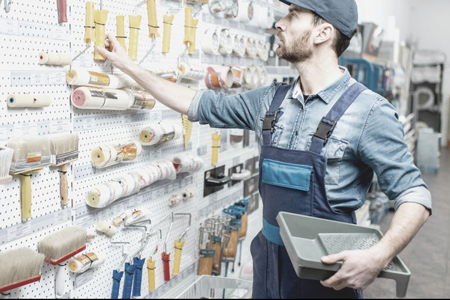Project Description

Rethinking the Retail Store Paradigm
Five Expert Steps to Finally Solve Omnichannel Execution
All major retailers endeavor to provide exceptional customer experiences, yet most fail with this objective because they are challenged with omnichannel execution. To some, these seem to be a singular goal, however, the difference involves inventory management and labor utilization.
Les McNeill, Founder and Chief Technology Officer of Impulse Logic, and Rob Oglesby, Senior Director at The Parker Avery Group argue that achieving exceptional omnichannel execution requires a fundamental paradigm shift about the role of stores in the modern retail environment. Based on decades of retail industry experience, their strong conviction is that retail stores are not a dying breed, but rather a critical asset to omnichannel execution.
In this article, in conjunction with Impulse Logic, Parker Avery outlines five steps retailers can take to adapt to the dynamics of the modern marketplace and achieve exceptional omnichannel execution. These steps infuse the use of artificial intelligence (AI) and machine learning (ML) technologies through predictive analytics with business process, store, and role changes to drive inventory accuracy, labor optimization, and ‘always assured’ inventory availability to customers. Further, implementing the new paradigm is both possible and can be quickly proven to provide meaningful benefits through improved inventory accuracy and better labor efficiencies.
Step 1
Understand the Need for Change
Even before the COVID-19 pandemic changed the world, retailers struggled with assuring inventory availability for both online and in-store customers. Exacerbated by the global crisis, this challenge was driven by two existing major industry problems:
- Ineffective inventory management—everything from forecasting the correct amounts to buy, allocate, and replenish to maintaining accuracy and visibility across and within multiple stores and distribution centers.
- Labor shortages and making the scarce store labor more efficient with “non-value” tasks so labor investment is focused on value-add tasks such as customer service—as well as keeping employees happy so they stay.
Prior to the pandemic, online retail had been growing consistently. In 2019, projections suggested that 20-25 percent of store sales would be online by 2024. The pandemic accelerated this growth, driving the anticipated four-year growth to be realized in just four months from February through May 2020. This unprecedented upsurge in demand, coupled with increased challenges with labor availability and supply chain disruptions, created the perfect storm for inventory availability challenges seen across the sector.
Reflecting on the changes in the retail sector, Les explained “The food/grocery sector got to omnichannel more in response to the impacts of Amazon entering the sector and the need to quickly counter the perceived threat.”
Mismanaged Receipts
Blind receiving in back rooms with allocation and replenishment models drives off inaccurate store perpetual inventory
Empty Shelves
Out of stocks require scarce store labor to visually inspect and replenish, often with no regard to actual store demand
Out of Stocks and Overstock
Sporadically placed overstocks, resulting from not understanding precise, actual quantities in locations within the store
According to Rob, “The important first step is to understand that the paradigm shift required to realize an efficient omnichannel store is not life-threatening. It does not require a rebuild of the store, nor does it suggest an increase in the volume of products being delivered to the store. Further, the labor changes do not impose anything more than what is required already. In the new paradigm, store-level tasks are only generated in response to inventory events essential to ensuring product availability within the omnichannel structure.”
Les agreed, “The first step is the recognition that any ability to deliver an omnichannel store needs to consider the integration of retail and digital. These two sides of retail have evolved as independent business units directly competing for supply availability, but requiring the use of retail personnel resources for omnichannel fulfillment. The starting ‘innovation’ was the recognition that digital and retail integration must focus on how to best utilize labor resources cognizant of the two units being part of a singular omnichannel execution. This was the baseline driving the enabling technology innovations.”
Step 2
Fix Inventory Accuracy
In an omnichannel environment, store inventory must be precisely organized and managed to meet customer expectations, no matter what purchase platform they use, as well as to drive labor efficiencies.
Rob explained, “Inventory accuracy at the location level is the foundation for this paradigm shift. While it will never be perfect, inventory accuracy is the building block for omnichannel execution. And it must be not just a total number at the store level but distinct locations within the store: backroom, “home” locations, end caps, etc. Accuracy and visibility at this detail provide a reliable number for each SKU so the right action can be taken.”
Rob continued, “A functioning omnichannel store requires a level of precision that most retailers seem reluctant to address as it requires a rethink of how perpetual inventory works and why a move to location-based inventory is needed. In today’s model, once a product arrives at the store, most retailers can know they have X number of units of a particular item but don’t necessarily know where it is. They understand the net quantity they have on hand but leave it at that. This approach to inventory management no longer aligns with the purchasing behavior of today’s customers, and it’s just not good enough anymore.”
Here is where technology is playing a critical role. As Les explained, “We’ve shifted away from the concept of perpetual inventory, a model used by most big retailers. Continuous accurate counts are now required, and that can only be realized with a transition to location-based inventory that separates inventory count levels to identify what’s on the sales floor, what’s in the backroom, and what’s committed in the supply chain, yet to be received. Most important is the determination of true demand, for digital and in-store purchases, within each product’s delivery cycle to the store. It is in these areas that Impulse Logic is applying ML to determine not just where the stock is, but where it should be, and in what quantities. Today, very few retailers can accurately expose and use such intelligence in support of omnichannel availability within the local store. Without this knowledge, it is impossible to achieve accurate supply planning in balance with demand.”
Rob added, “This is absolutely a key aspect of it. The other critical part is its impact on the retailers’ cycle count. Without understanding how much of a product you have and where it is stored, you will mess up your perpetual inventory. If a retailer thinks they have 100 units in store but can only find 25 in a location, they will make an adjustment to replenish, leading to an unnecessary overstock of certain products. The winners are going to be those companies that break this paradigm.”
It is essential to know the precise physical location of products for optimal fulfillment, whether retail or digital. While critical to inventory accuracy, this precision also drives better supply chain reactions to store assortment adjustments in response to more accurate demand intelligence. Too often, poor inventory accuracy at the store sees an oversupply of products, as well as a failure to deliver the right products. Most retailers also include a buffer to ensure inventory is available to accommodate digital purchases while considering in-store shopper behaviors. This balance of demand and availability has a complicated relationship. To have local store control of inventory available for demand, the store must have an ‘always accurate’ view of inventory on the sales floor, in the back room, and an aggregate of the sum of both.
Step 3
Leverage the Backroom’s Controlled Environment
The next step is to conduct online order fulfillment primarily from backroom inventory. This approach uses a backroom structure that replicates the capabilities of a distribution center. Unlike the chaos of a sales floor and competition with retail store customers, the backroom should be a controlled environment, with precision management and FIFO controls that ensure open cases not exhausted by digital sales within allotted time frames are prioritized for sales floor replenishment. This is a key capability in optimizing labor utilization for omnichannel order fulfillment to bring the digital cost of sale closer to the retail cost.
However, due to backroom space constraints, performing all omnichannel fulfillment from the backroom is simply not feasible for most retailers. In a typical retail environment, the process becomes a hybrid approach of picking in batches from the sales floor, driven by an intelligent, pick list, and leveraging sales floor zones to promote efficiency. Picked items are then combined and staged as orders in the appropriate locations for customer pickup.
The Impulse Logic team looked at distribution center (DC) capabilities when designing how an omnichannel retail backroom needed to function to support inventory and labor efficiencies. In a perfect setup, the recommended backroom structure essentially replicates each sales floor department, holding inventory from which online orders are picked and the sales floor is intelligently replenished.
When reflecting on omnichannel execution and the potential for installing store micro-fulfillment centers (MFCs), the capex involved is somewhat prohibitive. The Impulse Logic solution applies ML technologies in combination with back room organization to enable MFC execution performance without the cost of automation. Further, the solution provides a backroom MFC equivalent that covers assured availability for both retail and digital from the same backroom supply.
This structure enables a labor utilization model in the backroom to facilitate much faster picking of products for both retail on-shelf replenishment and online order fulfillment. In some ways, the labor efficiencies rival the capabilities of an automated DC. This concurrent pick and replenishment capability reduced labor by more than 20% while cutting execution times and costs in half.
Step 4
Intelligently Align Assortment with Demand
Retailers must then start managing the assortment more aggressively, all the way down to the store sets (planograms) as well as reviewing store configurations to make potential additional adjustments to further optimize efficiency. As an example, more space may be shifted to the backroom in stores with high volumes of online orders. This step involves more precise demand planning through better data.
According to Les, “It doesn’t matter how good the central demand planning algorithms might be when they are executing off bad data from the store. A customer unable to make a purchase due to an empty facing represents unrecognized demand for that product. On the flip side, selecting an alternative product creates an undeserved demand data point for the substitute product. Only by assuring continuous on-shelf availability can we realize a POS data feed reflecting true demand.”
Both Rob and Les believe that by using actionable data, retailers can reduce their overall inventory in a store and still service the consumer better. As Rob explains, “If we can get to the point where retailers are detecting and understanding what the actual demand is on a store level, the store is equipped with the insights and toolset to reshape the customer shopping experience. Here, store-level forecasting and planning can only be achieved if retailers know the real demand at a local store level.”
Les adds, “Part of our objective is to enable retailers to accurately predict product demand more than a month into the future and to expose this demand per each delivery of the product within that forward view. Product delivery cycles vary based on the nature of a product, the storage space available in the store, and the demand volume involved. If we look at a store assortment that covers around 50,000 SKUs, the ability to organize supply in balance with demand within each product’s delivery cycle to the store will immediately maximize return on inventory, while also reducing the overall inventory carry.”
Balancing supply with demand within delivery cycles has an even more profound impact on fresh and perishables items, whose losses from overstock markdowns and excessive shrink assignments run around 8% of overall sales in the fresh categories. This translates to nearly 4% of overall store sales. Having inventory management assure customer purchase availability limits losses in the fresh categories solely to items being damaged and unsuitable for sale.
Step 5
Employ Machine Learning to Improve Store Labor Efficiency
Fixing inventory and leveraging the backroom leads to the next phase of ensuring efficient on-shelf inventory availability: labor efficiency. Labor efficiency is driven by associates who are more targeted in their store activities, whether it is restocking shelves, fulfilling online orders, or providing customer service.
Les opined, “How do retailers know what’s on the shelf versus what’s in the backroom? Right now, the only determination of that is a labor effort, where a store associate walks the aisles looking for lows and holes needing replenishment. Each detection usually involves a scan to verify whether inventory exists in the backroom, and if it does, a replenishment pick will be manually executed for the product without regard for quantity counts, as inventory resides in the perpetual inventory ‘blob’ count. This massively poor utilization of labor usually results in multiple replenishment journeys between the backroom and sales floor, with the added challenge of not really being sure of backroom availability. In a tight labor market, these checks for lows and holes are often given lower priority in favor of online order picking and other activities. Having more resources available doesn’t make this process any more efficient—only more costly. With new technology such as Impulse Logic’s SLiQ, the determination of shelf availability has no dependency on visual gap checking and scanning at the shelf.”
“This clever application of ML enables retailers to make better decisions and take more efficient actions.” Rob added, “For example, if a retailer knows they have a quantity of 25 on the shelf, it’s not the best use of labor to restock the shelf if the product is not seeing demand greater than the currently available shelf count—despite a greater shelf capacity. Using intelligent insights provided by ML and AI, retailers can know that the rate of sale on that item is only five units a day. With five days’ worth of supply on the shelf, restocking that item is not a critical action. Store associates can focus on the products that are higher in demand and more likely to be out of stock if they are not replenished promptly.”
Les continues, “By using ML applied to accurate and timely inventory and demand data, we can identify what products will hit minimum count and generate a picklist which is sent to dedicated backroom teams. We’ve just removed all sales floor labor usually required to physically scan shop shelves to spot gaps and then search the backroom for the relevant stock. The sales team can now actually focus on delivering good customer service, which, when combined with assured availability, is the combination needed to drive loyalty.”
The Impulse Logic technology is applied to the automatic determination of sales floor replenishments without requiring any visual gap checking or shelf scanning by sales floor department personnel. Sales floor personnel no longer have any involvement in assuring on-shelf availability, as that task now resides with the backroom teams supporting each of the sales floor departments. The outcome is a sales floor team now entirely focused on customer service and support.
Expected Benefits of Making the Paradigm Shift
Based on decades of research related to the impacts of inventory distortions arising from stores being either over or understocked to actual demand, the primary financial benefit of taking these steps to achieve exceptional omnichannel execution is bottom-line profit improvements. According to IHL Group, in 2011, across all retail, inventory distortion delivered $800B in operating losses. Today, this loss is nearer $1.3T and growing. In the food/grocery sector, this translates into 7.5% of total store sales at a time when the sector struggles to deliver 2.5% of sales to the bottom line. Reversing all these losses, all directly related to inventory, demand imprecision, and less than effective supply chains, would improve operating profits four times.
Additionally, there is the challenge of lost margins on the digital side due to the higher labor costs involved in the current processes. The expectation is a progressive reduction in the costs on the digital side arising from more efficient labor utilization processes and the ability to better integrate digital and retail labor tasks. These changes enable the same backroom team to manage and assure inventory availability to customers across both channels.
Final Word
Each step of this paradigm shift feeds on the other steps. The entire model becomes increasingly more intelligent as inventory accuracy, demand planning, and labor efficiencies improve. Further, according to Les, initial benefits associated with moving towards this type of omnichannel execution can be achieved in 90-days without changes to existing legacy systems.
“The biggest benefit is having the stores fully exploiting the existing assets of inventory and labor while realizing the ‘local’ omnichannel capability,” Rob concluded. “This is the foundation of an evolution that immediately delivers on the functional aspects we have been discussing. It is, however, just the start, as the progression will lead to advances in merchandising to see adjustments in facing count capacities and assortments driving a better return on inventories flowing through the store. Additionally, we are creating omnichannel execution best practice processes uniformly applied across all stores. From an employees’ perspective, the store is now an operating warehouse serving retail and digital where personnel can evolve career paths starting with ownership of the backroom department warehousing as the first step on a very different career ladder.”





